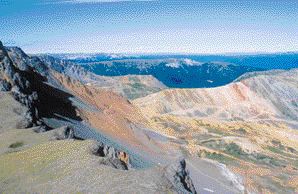Exploration at the Kemess gold-copper project in northwestern British Columbia has shown two new porphyry copper-gold occurrences east of the known Kemess North deposit, one of which yielded the longest mineralized intersection yet seen in that camp.
Northgate Minerals (NGX-T, NXG-X) said that drill holes targeting deep induced-polarization anomalies east of Kemess North had intersected long intervals of low-grade gold and copper mineralization in two zones, Ora and Altus. The mineralization at Ora, immediately east of the Kemess North resource envelope, is at about 850 metres vertical depth; that at Altus, about 1 km east of Kemess North, extends from 300 metres deep to surface.
At Ora, where mineralization was first intersected in a stepout hole from the Kemess North area in late 2005, three holes intersected significant lengths of gold-copper mineralization. The best intersection was 441 metres that ran 0.38 gram gold per tonne and 0.39% copper.
The two other holes graded 0.14 gram gold and 0.14% copper over 21.4 metres and 0.1 gram gold and 0.1% copper over 39.8 metres.
The area is broken by several faults and Northgate is following up on the intersections with holes on upwardly faulted blocks where similar mineralization might be closer to surface.
At Altus, three drill holes intersected a moderately dipping zone of copper-gold mineralization over long core lengths. A 155-metre interval graded 0.23 gram gold per tonne and 0.27% copper, another of 128 metres graded 0.23 gram gold and 0.33% copper, and one of 56 metres graded 0.18 gram gold and 0.3% copper.
While the Ora and Altus grades are relatively low, they both compare to Kemess North’s reserve grades. Kemess has 414 million tonnes in proven and probable reserves that contain 0.31 gram gold per tonne and 0.16% copper.
The operating open pit at Kemess South, where production is scheduled to last until the last half of 2010, produced 66,000 oz. gold and 6,700 tonnes copper in the second quarter of 2007, down from 76,000 oz. gold and 8,200 tonnes copper in the same period last year. Thanks to rising Canadian-dollar expenses, quarterly cash production costs rose to US$35 per oz. gold from a negative US$44 (including copper byproduct credits) the year before.
The Kemess mill processed 6% less ore than in the second quarter of 2006, largely because of greater downtime (11% of the quarter, against 6% in 2006). Most of the downtime arose from electrical maintenance at the mine’s transformer station, not from anything intrinsic to the mill. However, ore characteristics — much of the material processed in the recent quarter was supergene material — meant that gold recovery was only 69% and copper recovery only 83%.
Northgate earned US$8.6 million (US3 per share) on revenue of US$80.9 million in the quarter, versus US$50.3 million on revenue of US$105.3 million in last year’s second quarter. At the halfway point of the year, Northgate is showing a profit of US$18.1 million on revenue of US$155.2 million; it made US$72.1 million in the first half of 2006, on revenue of US$190.4 million.
Gold sales during the second quarter averaged US$564 per oz. against an average spot price of US$667 per oz. Northgate realized an average copper price of US$7,190 per tonne in the same period, against a London Metal Exchange average of US$7,650.
Northgate continues to hedge its production, however, and contracted for 16,200 tonnes in forward copper sales during the quarter at an average US$5,555 per tonne (US$2.52 per lb.). That deal — which locks in copper at a little less than twice its average price for 2000 through 2006 — covers essentially all new copper reserves at Kemess.
Work continues at Northgate’s Young-Davidson gold property near Matachewan, Ont. An underground exploration decline is one-quarter finished and some drilling from underground drill stations should start in the fall. The former production shaft has been dewatered to a 180-metre depth. Environmental and design work is also under way.
A preliminary economic assessment of production from Young-Davidson is also expected in the fourth quarter of the year. The deposit has a measured and indicated resource of 5.2 million tonnes grading 3.6 grams gold per tonne in three underground zones, Lucky, Lower Young-Davidson, and Lower Boundary, plus a 6.8-million-tonne measured and indicated resource in a proposed open pit, at an average 2.1 grams gold per tonne. Inferred resources in the three underground zones amount to 4.7 million tonnes at 3.7 grams gold per tonne, plus another 3.9 million tonnes at 4 grams in the Upper Boundary zone. There are another 330,000 tonnes of inferred material, grading 1.3 grams per tonne, in the pit area.
Recent drilling has extended the Lower Boundary zone up and downdip, the updip hole intersecting 18.8 metres grading 4.2 grams gold per tonne and the lower one 33.6 metres grading 2.8 grams. Another hole intersected two narrow zones of gold mineralization (2 metres and 4 metres) below the Lucky zone, and three holes on the western edge of the Young Davidson zone intersected unmineralized syenite and confirmed the zone does not continue to the west.


Be the first to comment on "New zones at Kemess"